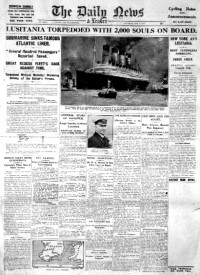 The Daily News & Leader (London, UK)
The Daily News & Leader (London, UK)
- The Future of Constantinople (Nov 11, 1912)
- The Shock of War. Through Germany to Cracow (Mar 29, 1915)
- To Poland in War-Time. A Journey into the Past (Mar 31, 1915)
- Poland Revisited: The North Sea on the Eve of War (Apr 6, 1915)
- My Return to Cracow. Poland in War-Time (Apr 9, 1915)

8 May 1915
Founded by Charles Dickens in 1846, The Daily News was one of Britain's leading Liberal journals, advocating a 'Little Englander' programme of free trade, social reform, and anti-imperialism. In 1904, it followed The Daily Chronicle, its main Liberal rival, in cutting its price from a penny to halfpence. Publisher of Henry Labouchere's famous dispatches from besieged Paris during the Franco-Prussian War of 1870, it attracted an array of notable contributors: Andrew Lang (leader writer), David Low (cartoonist), Henry William Massingham (parliamentary reporter), G.K. Chesterton (columnist), Charles Masterman (literary editor), John Lawrence Hammond (leader writer), E.T. Scott (financial correspondent), and Arthur Ransome (Russia correspondent), as well as George Bernard Shaw, Alfred Noyes, and H.G. Wells. Edited by Frank Harrison Hill (1870-1886), Sir Henry Lucy (1886-1887), Sir John Robinson (1887-1896), Edward T. Cook (1896-1901), Rudoph Lehmann (1901-1902), and A.G. Gardiner (1902-1919), it merged with The Morning Leader (companion paper of The Star) to become The Daily News and Leader in 1912. After further mergers with The Westminster Gazette in 1928, and The Daily Chronicle in 1930, it was finally absorbed by The Daily Mail in 1960.
In the late 1890s, The Daily News became a mouthpiece for the Imperialist faction of the Liberal Party, who used its pages to argue Britain's side during the Boer War. This stance was reversed in 1901 when it was purchased for '100,000 by parliamentarian David Lloyd George and Quaker manufacturer George Cadbury, who ran the paper at a loss. Under Gardiner's vigorous editorship, The Daily News pursued a range of Radical causes, including land reform, disarmament, state intervention in welfare, and a minimum wage. In the General Election of 1906, the same year in which it organized an Exhibition of Sweated Labour to highlight conditions among the working poor, most of its staff were returned to Parliament in Liberal seats. Soon after, Ramsay MacDonald sought to buy The Daily News as an organ for the fledgling Labour Party. From a low of 30,000 in 1902, circulation rose to 168,000 by 1908 -- allegedly the largest of any halfpenny morning paper in the world -- and perhaps reached 350,000 by 1913. Gardiner's dismay at Lloyd George's decision to stay in government during the First World War, which he expressed in increasingly critical editorials, led to his dismissal in 1919.
Conservative by inclination, Conrad was scornful of the social reformism and pacifism of what he called 'that depressing and righteous rag the D[ai]ly News' (CL 4:137). Even so, his circle of friends included at least two Daily News journalists: Perceval Gibbon, who covered the 1912 Balkan War; and maritime novelist Henry Major Tomlinson, who became leader-writer in 1912 and foreign correspondent during the First World War. The Daily News was also an influential arbiter of literary standing, and Conrad reacted sharply to a review of 'Twixt Land and Sea by Irish nationalist Robert Lynd in The Daily News of 14 October 1912, telling John Galworthy: 'There is an ass who tells me in [the] D[ai]ly News on god knows what provocation that I am a man "without country and language"' (CL 4:110).
Sources
Conrad, Joseph. Notes on Life and Letters. Ed. J. H. Stape with Andrew Busza. Cambridge: Cambridge University Press, 2004.
Dale, Alzina Stone. The Outline of Sanity: A Biography of G.K. Chesterton. Grand Rapids, MN: Eerdmans, 1983.
Davies, Laurence, et al., ed. The Collected Letters of Joseph Conrad. Cambridge: Cambridge University Press, 1983-2008. 9 vols.
An Index to the Fiction Published in The Star.
Kibble, Matthew. '"The Betrayers of Language": Modernism and the Daily Mail'. Literature & History 11/1 (Spring 2002): 62-80.
Koss, Stephen E. Fleet Street Radical: A. G. Gardiner and the Daily News. London: Archon Books, 1973.
Morris, A.J.A. Edwardian Radicalism, 1900-1914: Some Aspects of British Radicalism. London: Routledge, 1974.
Niland, Richard. '"Who's that fellow Lynn?": Conrad and Robert Lynd'. The Conradian 33/1 (Spring 2008): 130-44.
Stape, J. H., and Owen Knowles. A Portrait in Letters: Correspondence to and about Conrad. Amsterdam: Rodopi, 1996.